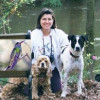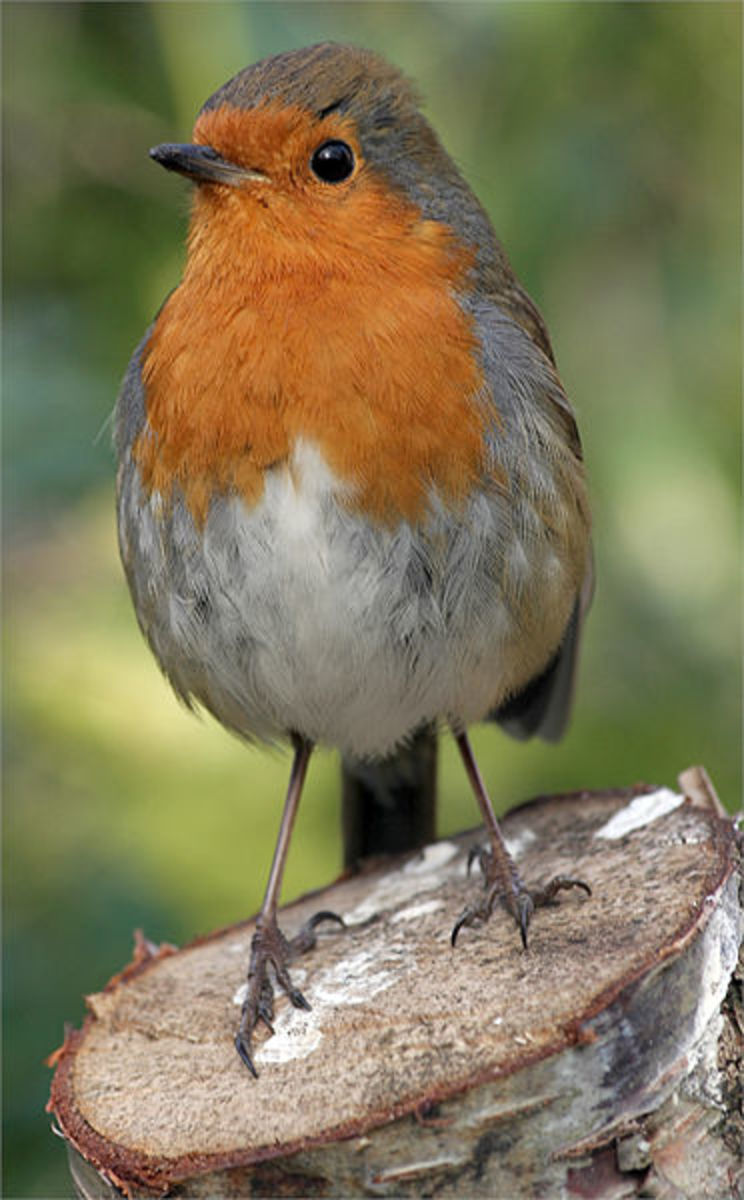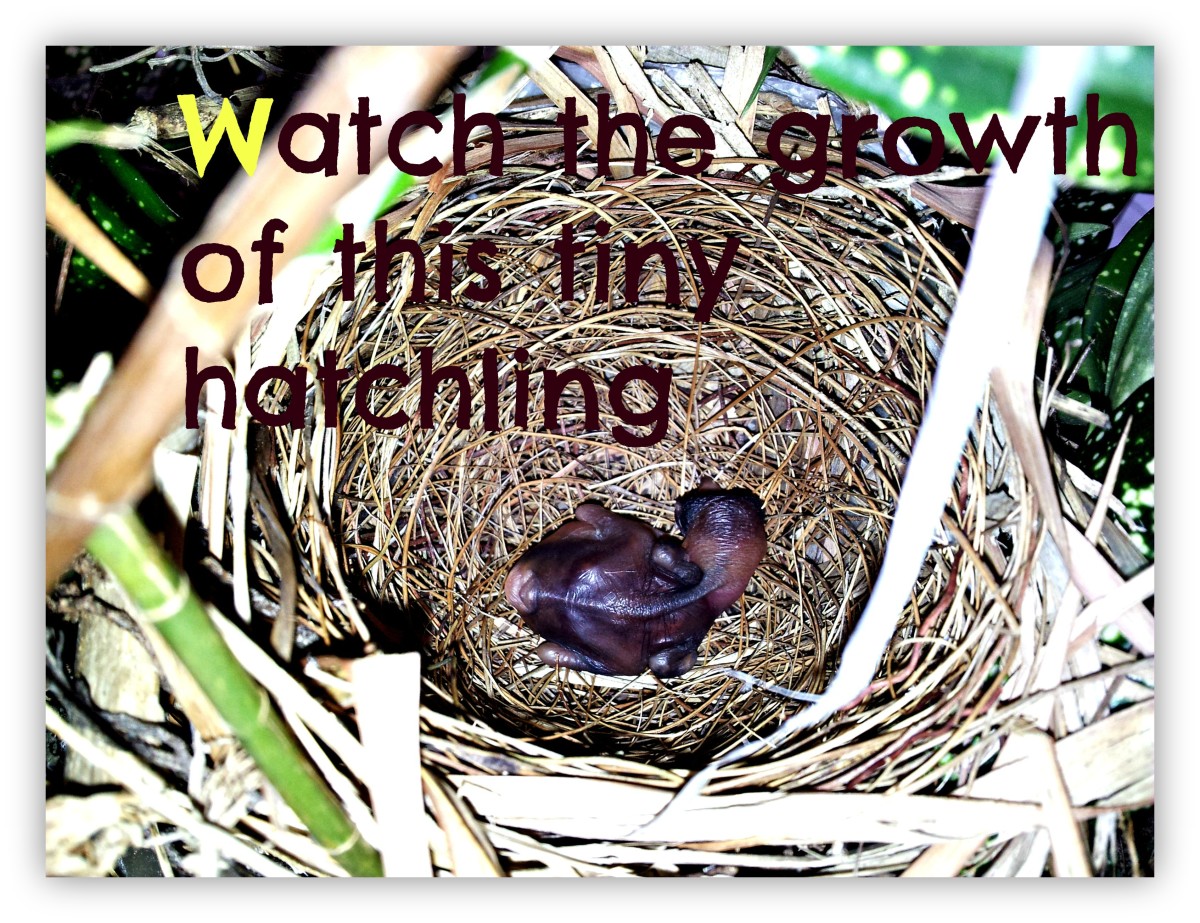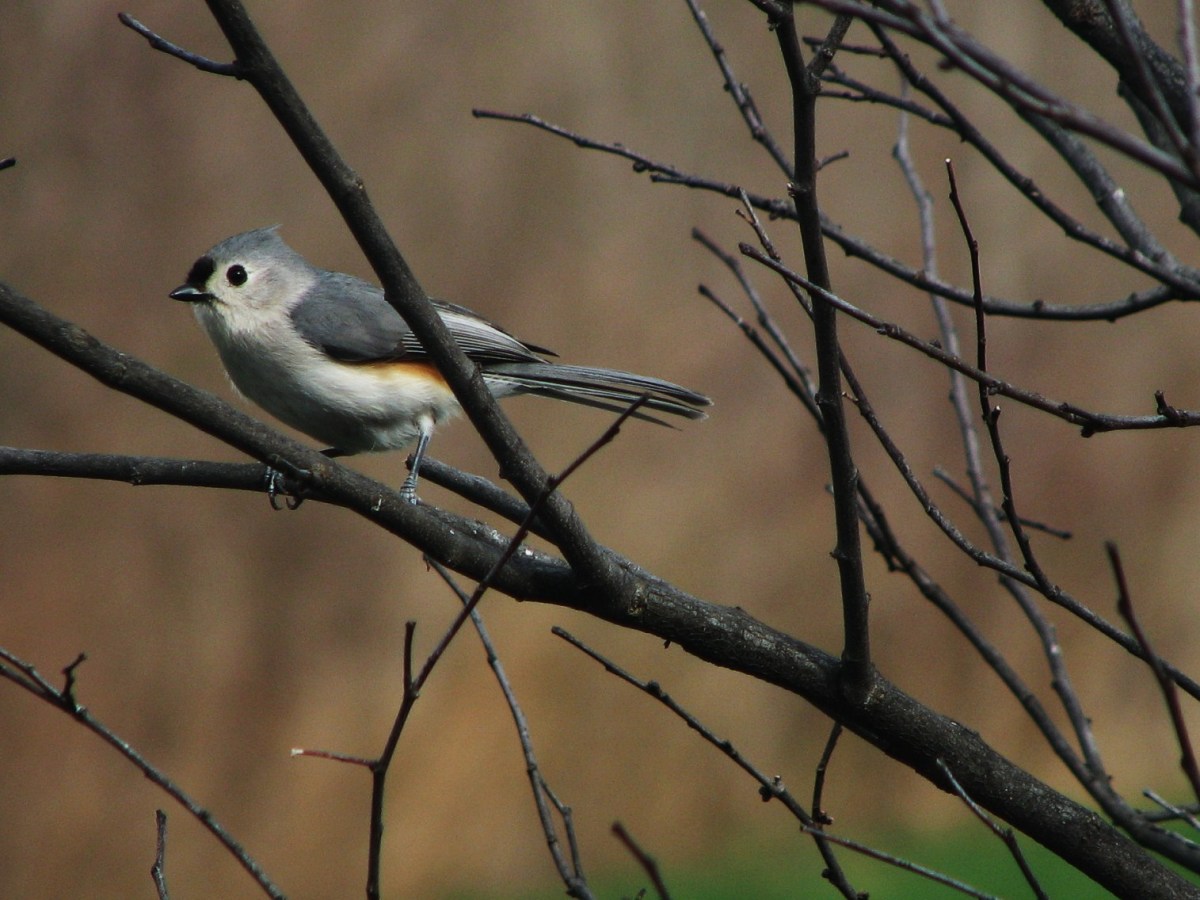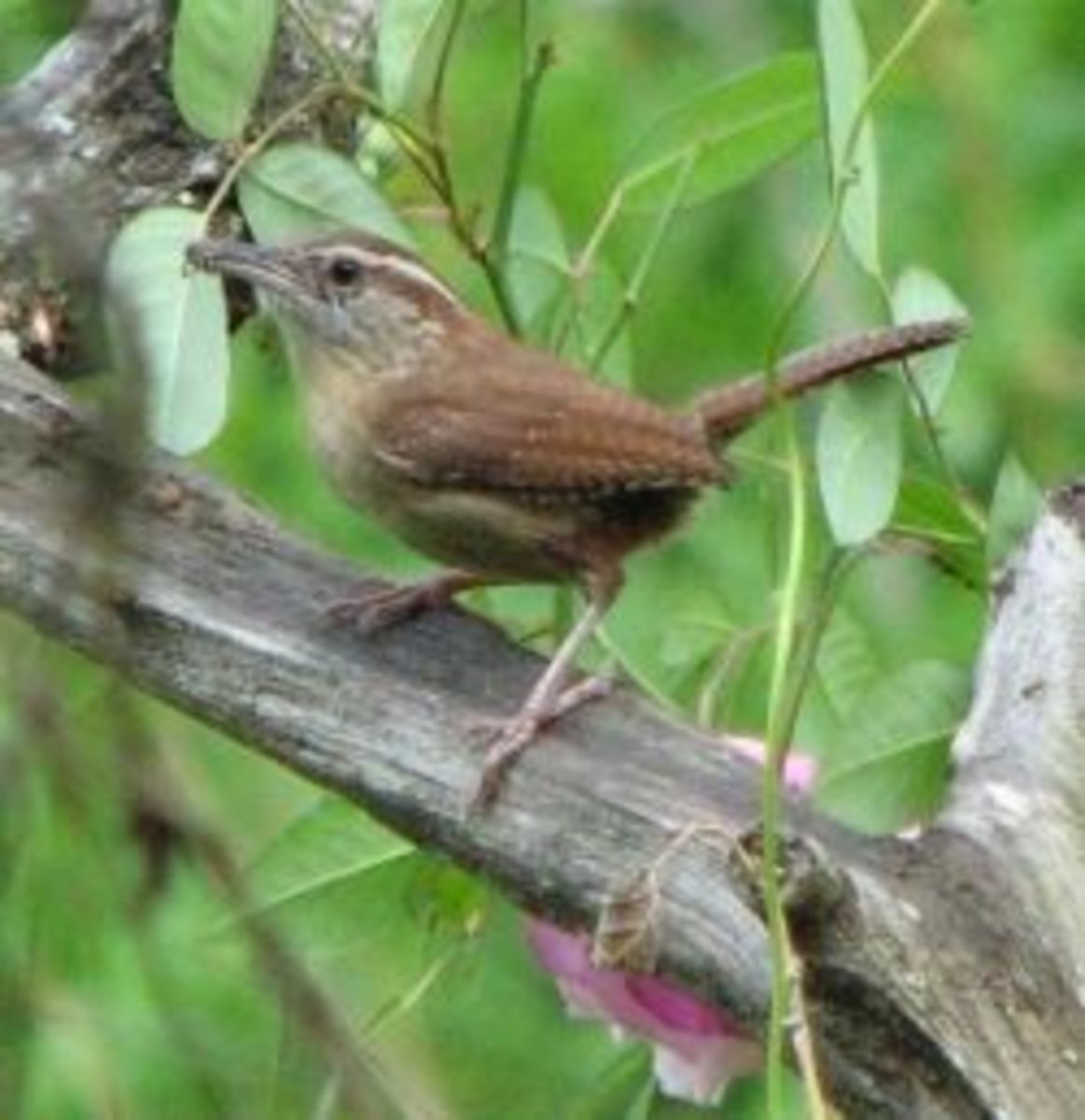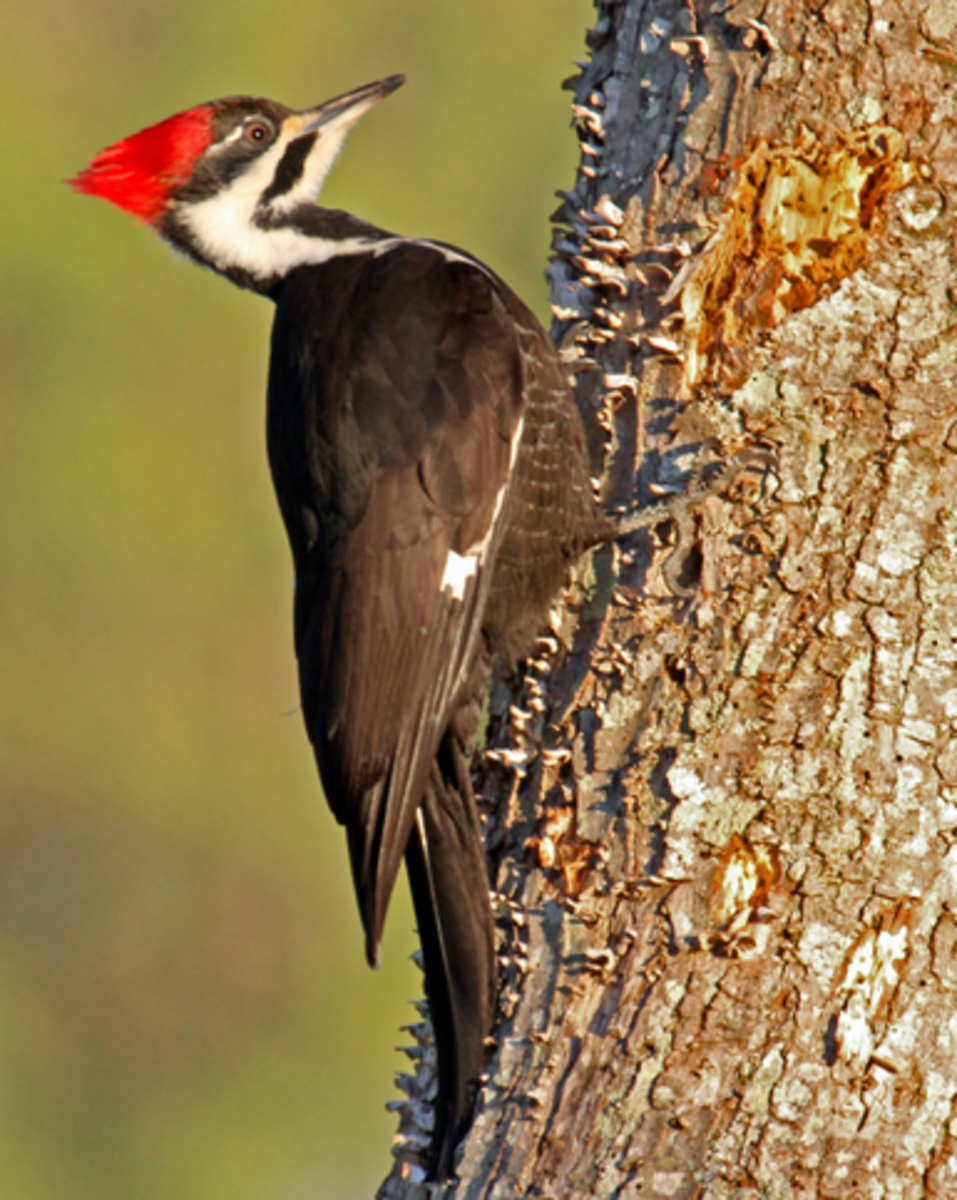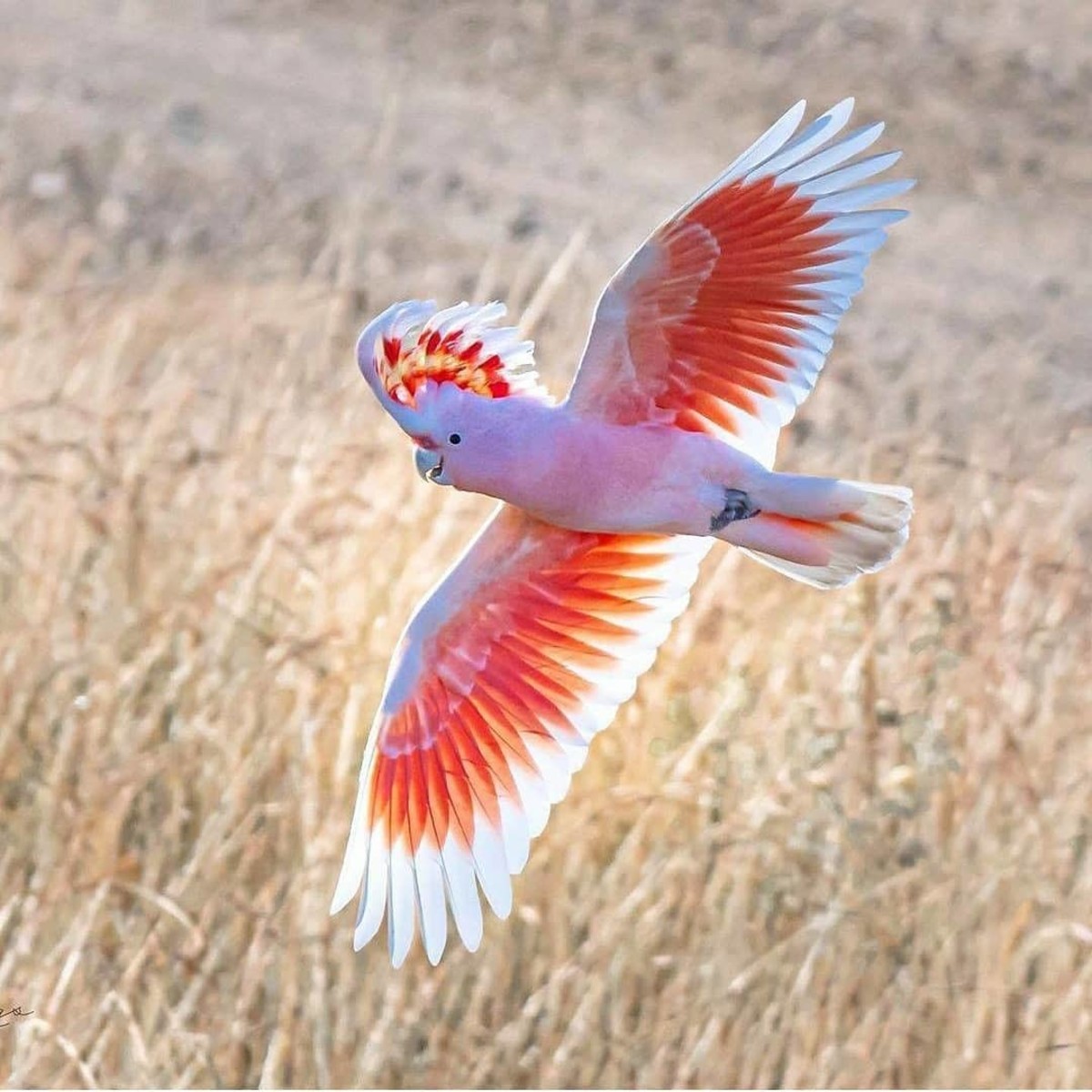Prothonotary Warblers are Golden
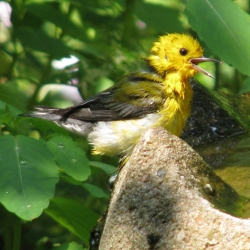
Photos of Nesting Prothonotary Warblers
Prothonotary Warblers are lovely little yellow birds with blue gray wings. They are becoming more rare as their wetland and swamp habitat is cleared and filled. If you live near water, you can help these perky little birds by erecting birdhouses and nest boxes for them to raise their young.
Here you will find photographs, taken by the author, of baby and adult Prothontary Warblers in their natural habitat and around dwellings. We hope you enjoy your visit here, where you will find information about all aspects of the interesting little bird. You'll also find a photo journal of the parents caring for their young and the baby warblers leaving the nest.
Prothonotary in Grape Leaves Postcard
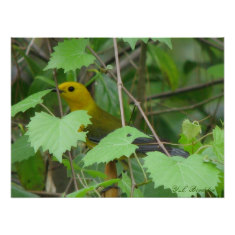
Prothonotary Warblers in the Little Tchefuncte Habitat
A small golden yellow bird with blue gray wings darts across Pruden Creek. Its clear, high, metallic rising "tsweet tsweet tsweet tsweet tsweet" song rings out through the forest. It lands and picks a clump of green moss, then flies to the hole in a nearby tree. "What is that lovely bird?", you may ask. It is the Prothonotary Warbler, whose numbers are declining due to the destruction of the wetlands where it makes its home.
Most of our property is wooded and only 1/3 of it is open area suitable for nesting bluebirds. Only 1 pair of bluebirds usually nests here, but we are blessed to have several pairs of Prothonotary Warblers nesting in our habitat. We first discovered this beautiful little bird shortly after we bought our place in the country on the Tchefuncte River.
Being nest box trail novices and not having time for more, we bought a Walmart bluebird box and nailed it to a tree. We also had a butterfly shelter box that someone had given us so we nailed it up to the gate post. Nothing used the nest box except the raccoon that ripped it off the tree. But we were surprised and delighted when a pair of small yellow birds with blue-gray wings built a small nest and raised 2 young in the butterfly shelter for 2 years in a row.
Prothonotary Bathes Poster on Zazzle
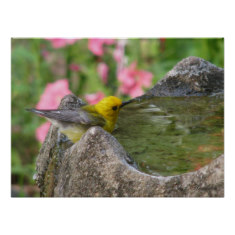
Description and Song
Prothonotary Warbler Description:
The Prothonotary Warbler is a small, active, insect-eating bird which is about 4.75 inches long. It has a thin pointed bill (black during the breeding season). It often inhabits swampy or wet forested areas.
The males have golden-orange heads and the females and immature birds' heads are yellow. Their back is olive and they have a clear yellow breast, underparts with no streaks, white undertail coverts and blue-gray wings and tail. The tail has white spots in it. The legs are black.
Listen to the Song of the Prothonotary Warbler from the PWRC.
The Prothonotary Warbler was once called the Golden Swamp Warbler because of its beautiful golden yellow color and flooded forest habitat. This warbler obtained its current name from 18th century Louisiana Creoles who thought the bird's plumage resembled the golden robes of the protonotarius, a Catholic church official who advised the Pope.
Early ornithologists had classified the warbler in the same genus as the waterthrushes, and later categorized the species as the sole member of its own genus, Protonotaria. The species name, citrea, refers to the lemon yellow color of the bird.
Courtship and Nesting
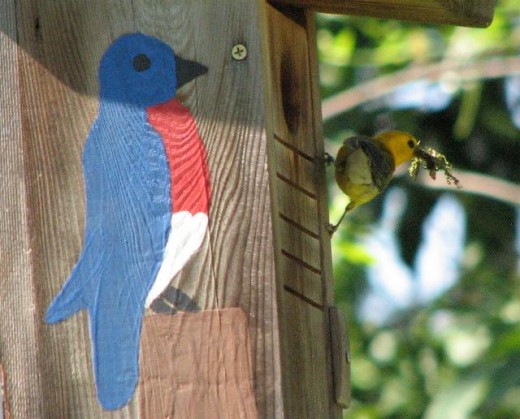
Prothonotary Postcards on Zazzle
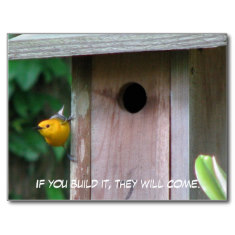
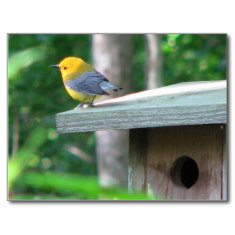
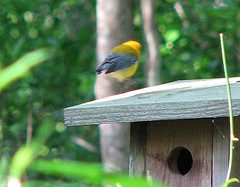
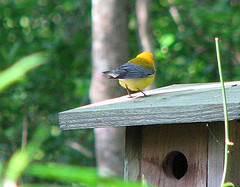
The prothonotary is the only eastern warbler that nests in holes in trees. It usually nests in abandoned Downy Woodpecker holes, but the warbler will nest in a variety of natural cavities in dead branches, the broken top of a stump, or the "knee" of a cypress tree.
Prothonotary warblers will also use standard bluebird boxes, but they seem to prefer a smaller box, more the size of a half gallon milk carton or a box designed for a wren or a chickadee.
Because of the availability of suitable nesting cavities, Prothonotaries are notorious for nesting in unusual places. We've had them turn their "beaks" up at well made wooden bluebird boxes to nest in a butterfly shelter box, uninsulated cardboard milk cartons and a decorative house that we hung on our porch. A neighbor had a pair nest in the cinder blocks that her a/c compressor was on. They have also been found nesting in the pocket of an old coat, tin cans and the pulley on an active ferry. Sometimes the cavity sites chosen are not very well enclosed, and prothonotaries on rare occasions have been found to use abandoned nests of open-nesting species.
In the spring, after the females arrive from the wintering grounds in Central America, the males begin courting. Each male has already staked out a territory that contains several possible nesting sites and he has reserved those sites by placing green moss in the cavity. Once he attracts the eye of a lady fair, the song and dance begins. He is much like a barker in the carnival advertising his great box by saying, "Come see, Come see, Come see, all you lovely ladies. Come see what I have to offer." Here are some photos that we took of a perky little male who was really showing off.
Most of the photos seen here are available for purchase in naturegirl7's shop on Zazzle.com. Zazzle is a print-on-demand site which offers many products such as posters, cards, mugs, apparel, postage stamps and more.
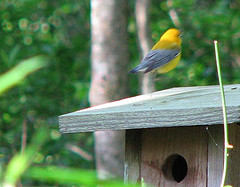
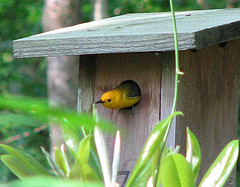
The female chooses her mate and selects the best site where she completes the nest. After the nest of moss with a cup of fine grass is built inside a tree cavity, hole in a stump, birdhouse, or other man-made structure, such as a mailbox, there is a delay of several days before 4-6 creamy-white, purple-spotted eggs are laid.
The female incubates the eggs for 12-14 days and begins either the day or the day before the last egg is laid. The chicks leave the nest (fledge) 11 days after hatching.
To see more pictures of nesting Prothonotaries, visit our Hub page, Pictures of Birds - Prothontary Warblers Nesting.
Also, be sure to check out the Prothonotary Warbler page at Silias.org.
Prothonotary Male in Bath Poster on Zazzle
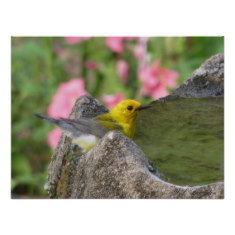
Prothonotary in Beech Postcard on Zazzle
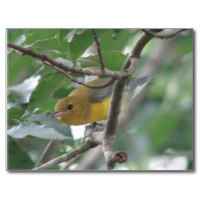
Habitat and Interesting Facts
Cavity nest-sites are not the only habitat requirement of the species. Prothonotary Warblers are usually found far near some body of water, whether it be a slow running river or creek, a large wooded lake or pond, their favorite flooded bottom land forests, or a low spot in the forest with temporary standing water. Backyard ponds and swimming pools can also attract Prothonotaries. This special attraction to water may be because of the higher number of dead and decaying trees with possible nest cavities in flooded areas and the added benefit of lower predation by mammals when the nest-site is located over water. Insect food for the growing chicks is also plentiful in swampy areas.
Nesting over water can present problems. Because Prothonotaries usually nests within a few feet of the water's surface, flooding accounts for quite a few nest failures each year. We have observed this first hand, and have relocated all of our boxes so that they are a few feet above the highest possible water mark. Another problem occurs when the poor-flying young fledge from a nest, because if they land in the water they may become a meal for a turtle or a large-mouth bass. But luckily, fledgling Prothonotary Warblers can swim! Many ornithologists have observed young prothonotaries flitting across the water to a safe log or branch.
Female on Decorative House
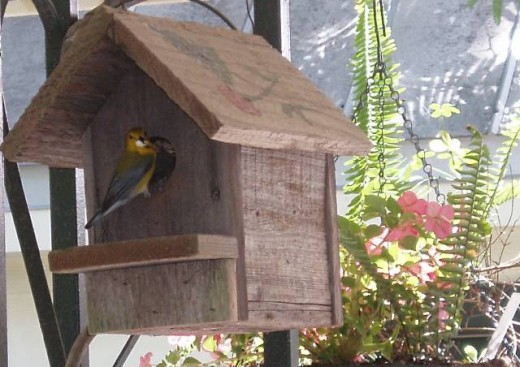
Prothonotaries spend the non-breeding winter season in southern Central America and northern South America, with their highest numbers in Costa Rica, Panama, and northern Colombia (where they inhabit the mangrove swamps). In the mangroves of Panama, the warbler can reach such high population density that early ornithologists described "swarms" of Prothonotary Warblers.
Their behavior during winter is the opposite of the aggressive territoriality of the breeding season. Wintering Prothonotaries exhibit almost no aggression against each other as they forage in large groups for insects and small snails among the aerial roots of the mangrove trees. Male and female Prothonotaries sometimes maintain their pair-bond on the wintering grounds.
Immature at Hummingbird Feeder
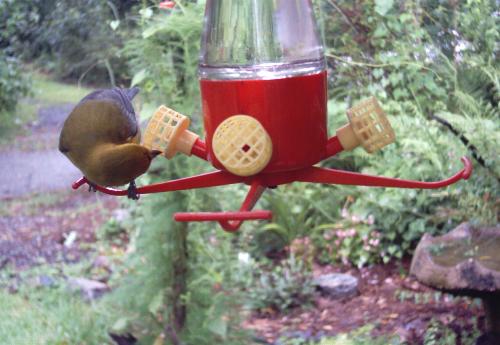
According to data from the North American Breeding Bird Survey, Prothonotary Warbler numbers have declined overall at a rate of 1.5% annually since 1966. Steeper declines are evident in some regions where the bird reaches its highest numbers, such as in the lower Mississippi Valley. Because of the warbler's very specific habitat requirements, wetland losses due to logging and development in both the bottom land forests of North America and the mangrove swamps of Central and South America threaten breeding and wintering populations. These birds are declining in numbers due to loss of habitat.
The Brown-headed Cowbird (Molothrus ater) also lays its eggs in these Warblers' nests causing death of the chicks and the House Wren (Troglodytes aedon) takes over many prime nesting cavities that Prothonotaries could have used.
Wikipedia says:
"The prothonotary warbler became known in the 1940s as the bird that, in front of the House Un-American Activities Committee, established a connection between Whittaker Chambers and Alger Hiss. Chambers had testified that Hiss enjoyed bird-watching, and once bragged about seeing a prothonotary warbler. Hiss later testified to the same incident, causing many members to become convinced of the pairs' acquaintance."
Prothonotary Male in Bottlebrush Poster
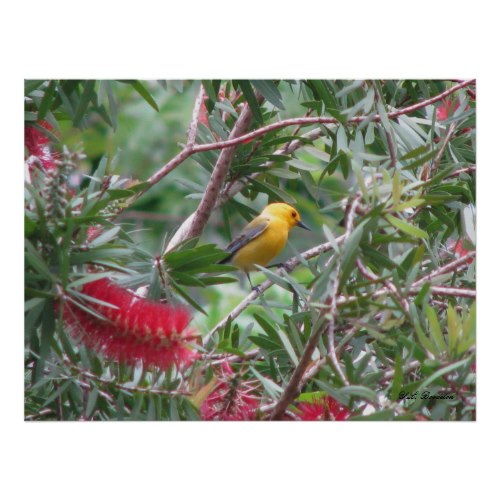
Buy Prothonotary Male in Bottlebrush Print and other art prints by naturegirl7 on Zazzle.com
Prothonotary Migration
Each spring and fall, the Prothonotary Warblers migrate from their breeding grounds here in Covington, LA to the Mangrove Swamps of Central and South America.
Prothonotaries in Nest Box Photographs
We added a piece of metal roof cap to the top of an old wren house and put it in our vegetable garden for decoration. Prothonotaries had nested in it before, but it was so threadbare that we didn't expect them to use it this year. But they had different ideas and a pair of Prothonotary Warblers built a nest and set up housekeeping. Of course, we were delighted to have a pair of insect eating birds with young, right there in our organic, sustainable garden. The Carolina Wrens, Eastern Bluebirds and the Warblers have kept our garden relatively pest free this year.
Even though the young stay in the nest for only 11 days, both parents start early in the morning and continue until dusk, making hundreds of trips back and forth to the nest box feeding the young and cleaning the nest. These photos were taken on May 18, 2008 (the 9th day after hatching).
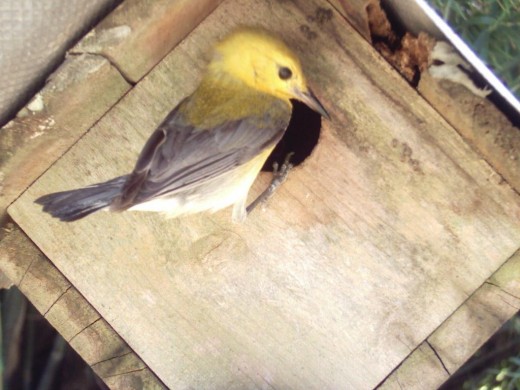
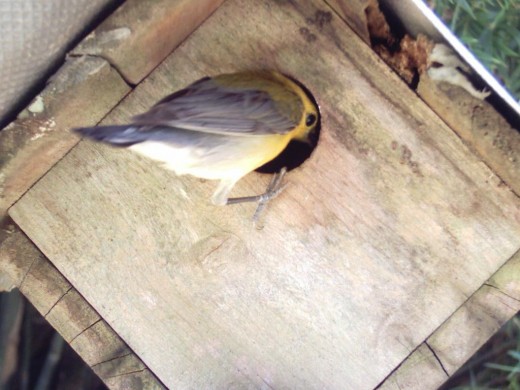
On May 19, 2008 (the 10th day after hatching) the young Prothonotary Warblers begin to peer out of the box when Mom and Dad aren't around. They are getting restless and will probably fledge in a day or so.
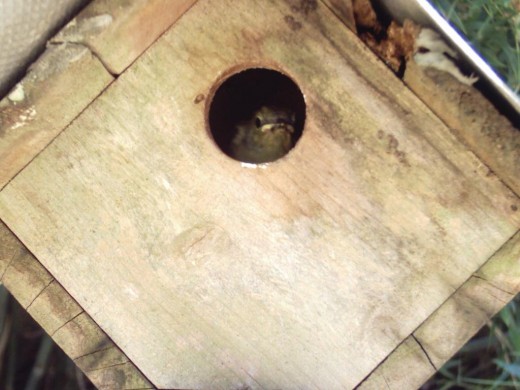
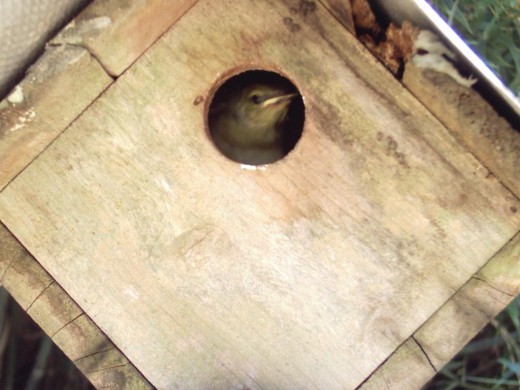
On May 20, 2008, the Prothonotary Warbler babies fledge! We think there were 3, but could not tell for sure because the little wren style house is impossible to monitor. The only way to see inside is to put your big eye in the hole and peer in.
Male

Female

Looking out on the world outside
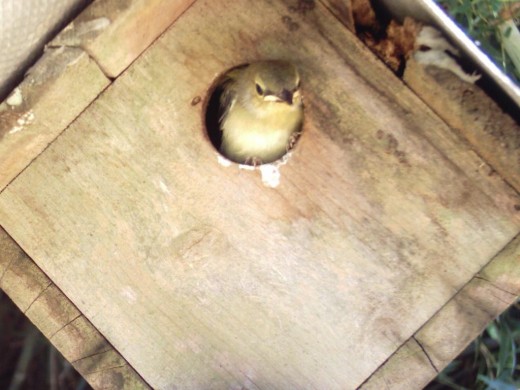
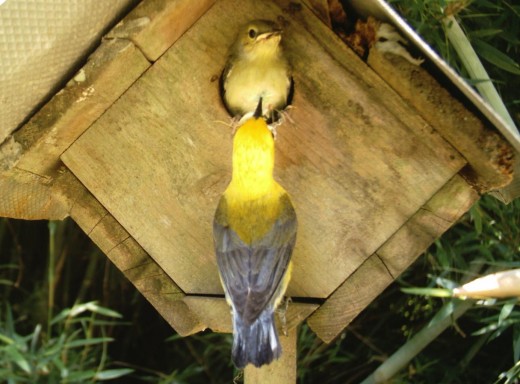
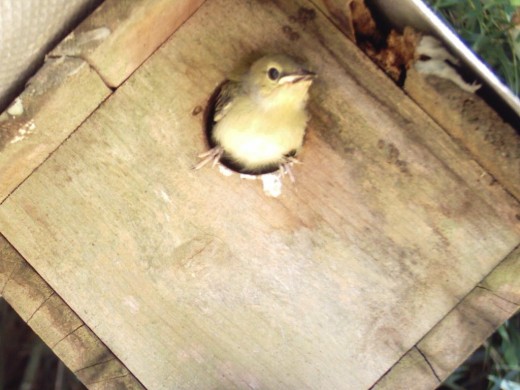
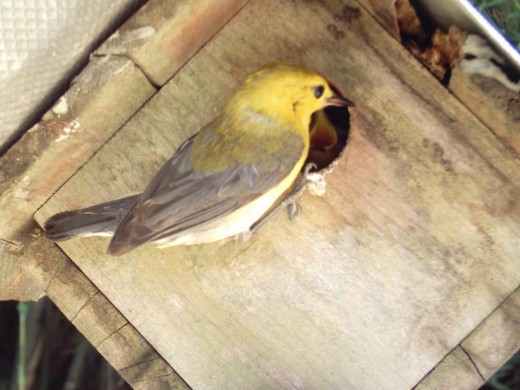
Feed Me!
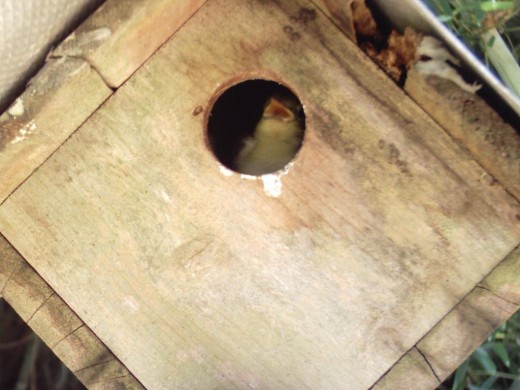
Here I go... off to see the world.
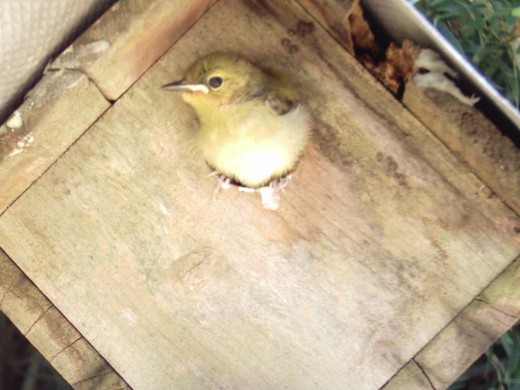
There is a good chance that they will build their second nest in the same box. We would prefer that they use one of the more secure boxes with the predator baffles, but we hope that they will build a second nest somewhere close by, because we enjoy their bright colors and inquisitive nature. This is one of four pairs that are nesting on our property this year. We think that, little by little, our nest box trail is helping to increase their numbers here in our habitat.
Prothonotary in Sourwood Poster on Zazzle
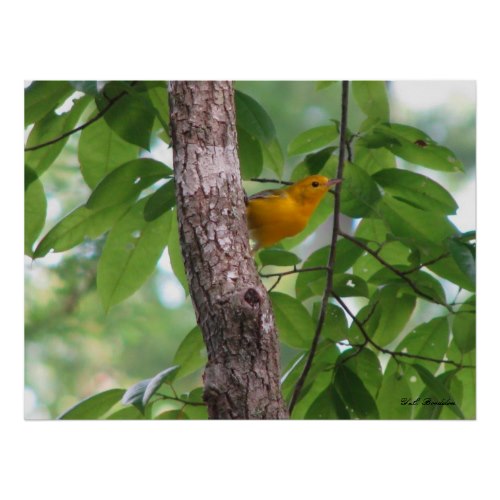
Buy Prothonotary in Sourwood poster and other art prints by naturegirl7 on Zazzle.com
Audubon Bird Cam
The Audubon Bird Cam (shown below) is a wonderful camera to use to take photos of nest boxes and baby birds. The camera that we actually used has been discontinued and we will be replacing it with an Audubon Bird Cam.
Prothonotary Warbler Poster on Zazzle
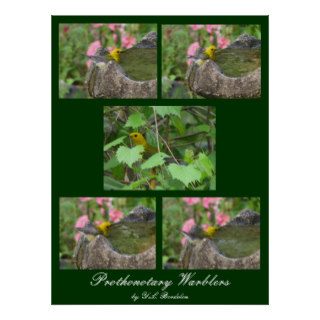
Prothonotary Bath Mug on Zazzle
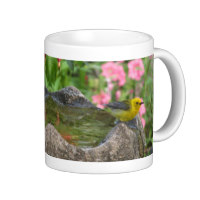
Prothonotary Warbler Video
Prothonotary Postage Stamp on Zazzle
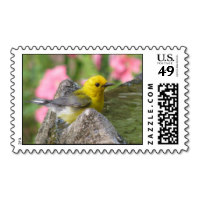
Protonotary Warblers at Nestbox - By Jack Dodson
A great video by a great nest box trail manager.
Prothonotary Stickers on Zazzle
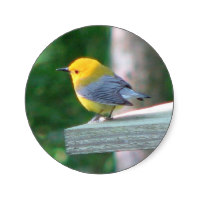
Stokes Chickadee Birdhouse
Prothonotary Warblers prefer small nest boxes like this chickadee birdhouse.
Bird Song Quiz
Zazzle Postcard
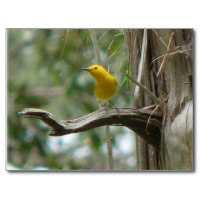
Warblers Books
There are many good bird books on Amazon.
The Warbler Guide
© 2008 Yvonne L B
